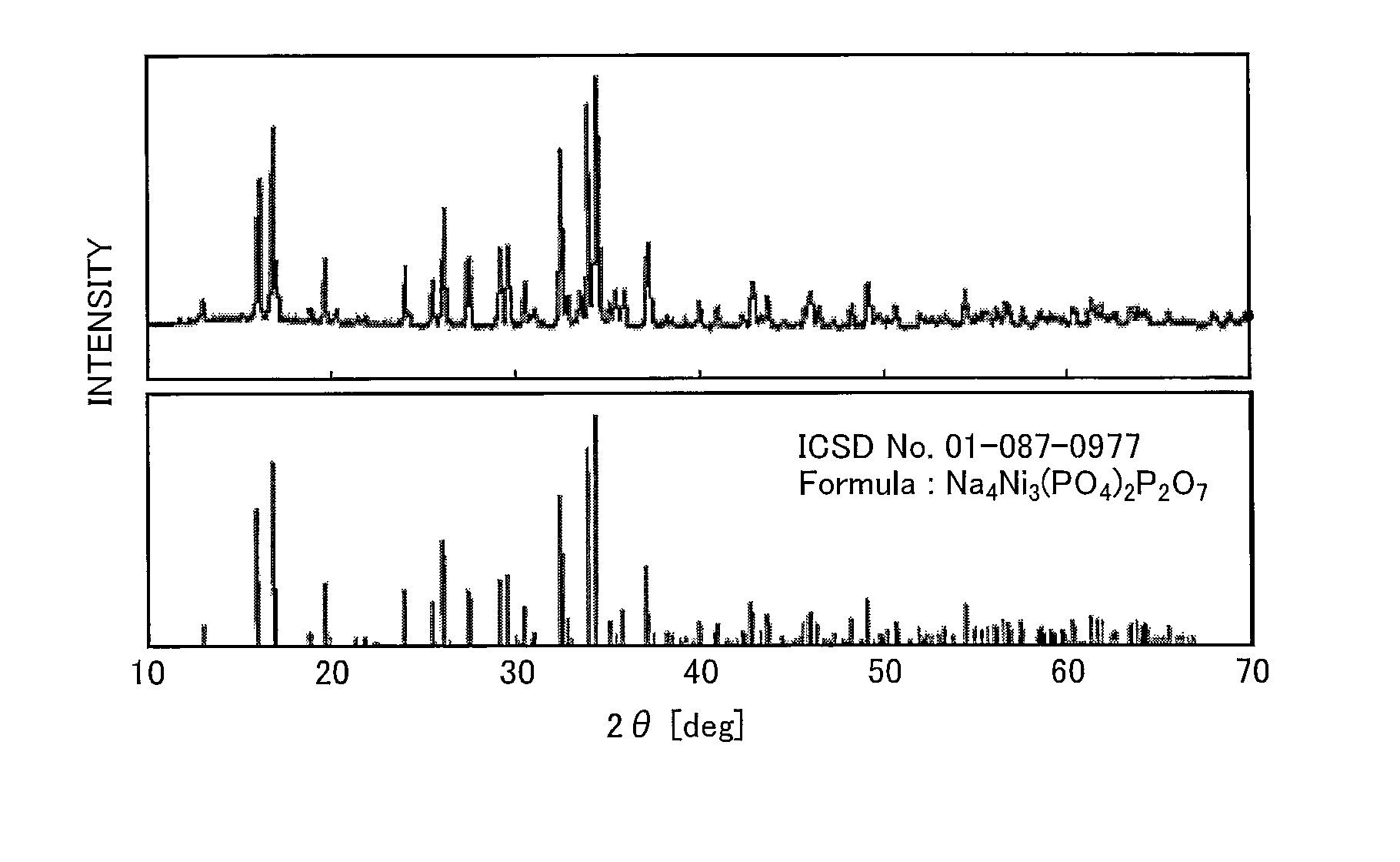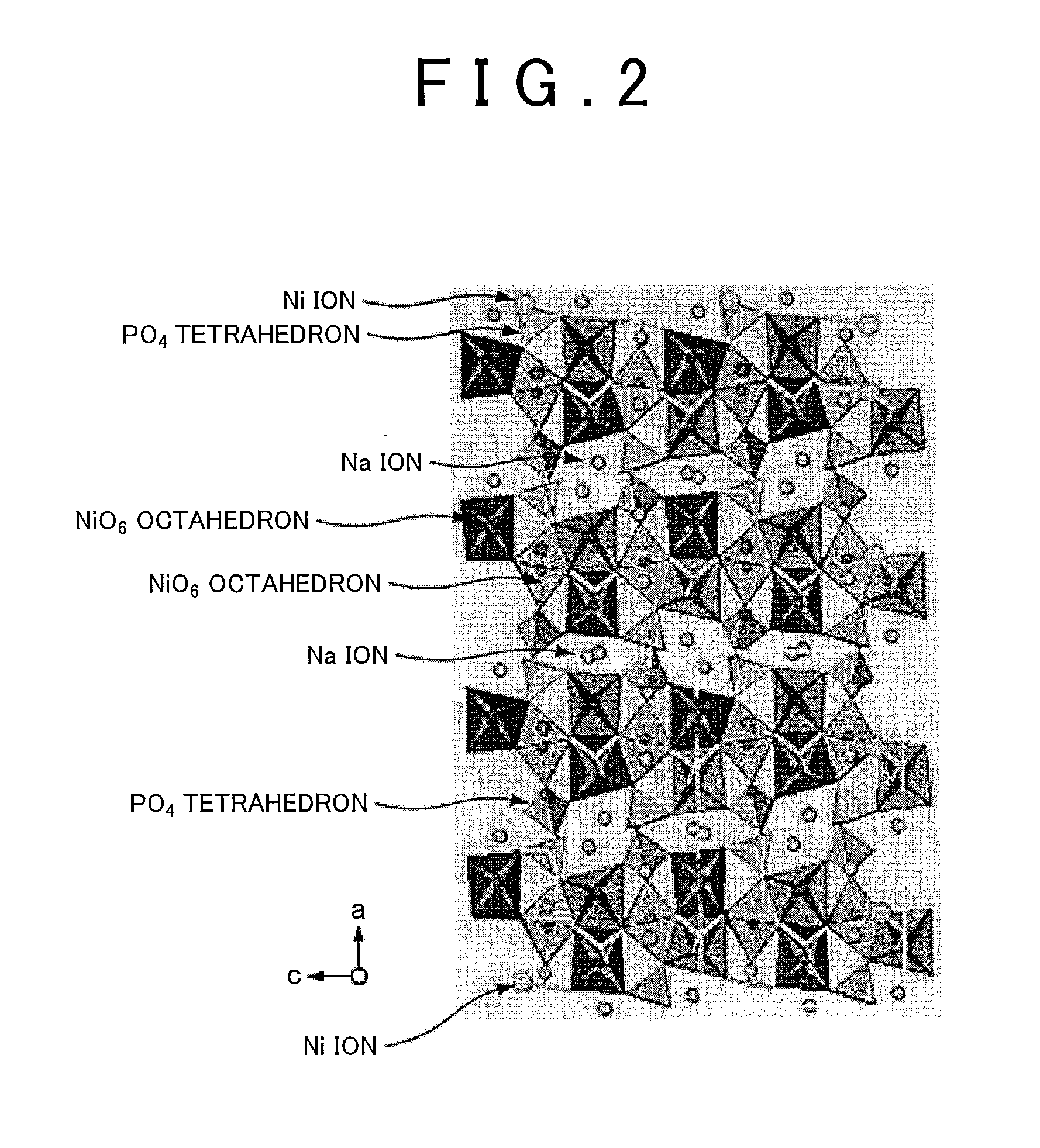Positive electrode active material for sodium battery, and method of producing the same
- Summary
- Abstract
- Description
- Claims
- Application Information
AI Technical Summary
Benefits of technology
Problems solved by technology
Method used
Image
Examples
example 1
Synthesis of Positive Electrode Active Material for Sodium Battery
[0147]Na2CO3 (Na-containing compound), (CH3COO)2Ni (Ni-containing compound) and NH4H2PO4 (P-containing compound) were mixed in a molar ratio of Na:Ni:P=4:3:4. The mixture was size-reduced using a ball mill, following which pre-firing was carried out in an open-air atmosphere at 300° C., and main firing was carried out for 15 hours at 700° C.
[0148]The crystal structure of the synthesized material obtained in the main firing step was analyzed with an x-ray diffractometer (XRD). The results are shown in FIG. 5. The top half of FIG. 5 shows the XRD pattern for the synthesized material, and the bottom half shows the XRD pattern for Na4Ni3(PO4)2P2O7 in the ICSD database (ICSD No. 01-087-0977). It was possible to confirm from FIG. 5 that the synthesized material obtained is Na4Ni3(PO4)2P2O7. In addition, this synthesized material (Na4Ni3(PO4)2P2O7) was continued to have a crystal structure belonging to the space group Pn21a....
example 2
Synthesis of Positive Electrode Active Material for Sodium Battery
[0164]Na4P2O7 (Na- and P-containing compound), (CH3COO)2Mn (Mn-containing compound) and NH4H2PO4 (P-containing compound) were added, together with glycolic acid (gelating agent), to an acidic solution (aqueous nitric acid solution) in a molar ratio of Na:Mn:P=4:3:4 and dissolved, and the solution was stirred at 80° C. The resulting gel was fired in an open-air atmosphere at 700° C. for 15 hours.
[0165]The crystal structure of the synthesized material obtained by firing was analyzed with an XRD. The results are shown in FIG. 7. From FIG. 7, the resulting synthesized material was confirmed to be Na4Mn3(PO4)2P2O7. The resulting synthesized material (Na4Mn3(PO4)2P2O7) was confirmed to have a crystal structure belonging to the space group Pn21a shown in FIGS. 1 to 3.
[0166](Evaluation of Positive Electrode Active Material for Sodium Battery)
[0167]
[0168]A slurry was prepared by mixing the Na4Mn3(PO4)2P2O7 (positive electrode ...
example 3
Synthesis of Positive Electrode Active Material for Sodium Battery
[0178]Na4P2O7 (Na- and P-containing compound), (CH3COO)2Co (Co-containing compound) and NH4H2PO4 (P-containing compound) were added, together with glycolic acid (gelating agent), to an acidic solution (aqueous nitric acid solution) in a molar ratio of Na:Co:P=4:3:4 and dissolved, and the solution was stirred at 80° C. The resulting gel was fired in an open-air atmosphere at 700° C. for 15 hours.
[0179]The crystal structure of the synthesized material obtained by firing was analyzed with an XRD. The results are shown in FIG. 9. From FIG. 9, the resulting synthesized material was confirmed to be Na4Co3(PO4)2P2O7. This synthesized material (Na4Co3(PO4)2P2O7) was confirmed to have a crystal structure belonging to the space group Pn21a shown in FIGS. 1 to 3.
[0180](Evaluation of Positive Electrode Active Material for Sodium Battery)
[0181]
[0182]A slurry was prepared by mixing the Na4Co3(PO4)2P2O7 (positive electrode active ma...
PUM
| Property | Measurement | Unit |
|---|---|---|
| Temperature | aaaaa | aaaaa |
| Temperature | aaaaa | aaaaa |
| Crystal structure | aaaaa | aaaaa |
Abstract
Description
Claims
Application Information
 Login to View More
Login to View More - R&D
- Intellectual Property
- Life Sciences
- Materials
- Tech Scout
- Unparalleled Data Quality
- Higher Quality Content
- 60% Fewer Hallucinations
Browse by: Latest US Patents, China's latest patents, Technical Efficacy Thesaurus, Application Domain, Technology Topic, Popular Technical Reports.
© 2025 PatSnap. All rights reserved.Legal|Privacy policy|Modern Slavery Act Transparency Statement|Sitemap|About US| Contact US: help@patsnap.com



